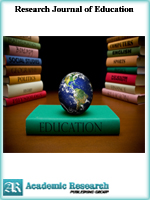Research Journal of Education
Online ISSN: 2413-0540
Print ISSN: 2413-8886
Print ISSN: 2413-8886
Quarterly Published (4 Issues Per Year)

Archives
Volume 1 Number 4 November 2015
Knowledge of Students about Rules and Regulations Guiding the Conduct of Examinations in Kogi State College of Education (KSCOE), Ankpa, Nigeria
Authors: Jacob Omede
Pages: 50-58
Abstract
This paper examined the “Knowledge of students about the rules and regulations guiding the conduct of examinations in Kogi state College of Education (KSCOE), Ankpa. This was with the view to suggesting measures that could reduce examination malpractices that have become resilient in most institutions of learning in Nigeria. Through stratified random sampling procedure, two hundred students admitted into the college in 2012/2013 academic sessions were sampled for the study. The instrument for data collection was a 49 items’ questionnaire that was divided into three sections A, B and C. Section A sought information on rules and regulations guiding examinations in the college, section B, required information on the knowledge of students about the behavior that constitute examination malpractice and section C sought to know their levels of knowledge on the prescribed penalties for the examination offences. The data collected were analyzed using mean and the findings were that students of KSCOE, Ankpa, have sufficient knowledge about the rules and regulations guiding examinations, behaviours that constitute examination malpractices and penalties for the examination offences. That examination malpractice is a deliberate act by students. In addition, there was no difference between the levels of knowledge of both the Christians and the Muslims. Recommendations were that culprits should be made to face the full wrath of the law, pastors and Imams in churches and mosques should work more on their members to instill into them obedience, godliness and respect for laws and orders. They are to be taught more intently the earthly and eternal consequences of disobedience and that invigilators avoid behaviours that predispose examinees to cheating among others.
Factors Influencing Unequal Cross Border Higher Education Students? Mobility in East African Community
Authors: Stephen Odebero ; Ulf Engel ; Mathias Middell
Pages: 35-49
Abstract
Education is now widely recognized as a scarce commodity but whose investment leads to future pecuniary and non pecuniary returns. Individuals invest in human capital (HC) with hope for future returns, while family investments expect social returns. Indeed governments in the East African Community (EAC) are motivated by the perceived social rate of returns. An emerging school of thought holds that Higher Education (HE) is a big business whose investment must be carefully planned. In EAC, cross border movement in search for HE has been to say the least, the most unequal. In her own admission, Kenya’s Minister of Foreign Affairs stated that the country loses over ksh 2 billion annually in students’ mobility to Uganda in search for HE. While this has gone on for years unabated, this study interrogates the central question: why is cross border HE students’ mobility in EAC unequal? The study generates a four tier typology of integration that includes (i) stagnant integration (LL), (ii)moribund integration (LH), (iii)synergistic integration (HL) and (iv) inequitable integration (HH) based on the relationship between students’ HE mobility and levels of inequality. Overall, the study advocates for the synergistic type of integration that encourages higher students’ mobility with lower inequalities. The study was done as a spatial variation based on the concept of extreme case selection and the most likely condition. Kenya, Uganda, Tanzania and Rwanda were seen as influential cases to be included in the study. Uganda was seen as the destination point for cross border students movement, while Kenya and Rwanda were the exit points. An extensive but selective review of existing literature was also done as well as modest collection of primary data which was done prior to the research visit. Greater premium was placed on empirical data and government reports. Quality appraisal strategy adapted was in line with the central research question in the initial proposal. Heterogeneity of included studies, the likely impact of bias and the applicability of the findings were also addressed. Inequitable cross border students’ movement is a product of many interrelated factors. The dominance of cross border students in Uganda’s tertiary institutions was largely attributable to the relatively lower cost of higher education in Uganda. However, varied tuition fees charged by HE institutions in EAC was a product of different corporate tax regimes instituted by partner states with Kenya and Tanzania registering the highest corporate tax regimes while Uganda and Rwanda had the lowest. Overall, the study established that asymmetries in systems of education practiced in EAC has disadvantaged Kenya as a destination of students mobility in search of HE. Students in Uganda and Tanzania, upon sitting their Advanced level examinations, expect to complete their basic university education in 3 years. Studying in Kenya, Rwanda or Burundi, would mean they are subjected to a 4 year curriculum and this would lead to unnecessary increase in duration and total costs. In the short run, universities in Kenya should consider reducing tuition fees in order to stem students’ movement to Uganda and possibly attract students from other countries in the region, however, in the long run, the EAC member states may need to establish a more comprehensive strategy to equalize tuition fees. To achieve this it may involve establishment of equalized taxation measures for education in the region. The reality is that EAC requires a unified system of education be it the 7-4-2-3 system or the 8-4-4 system of education. This idea is alluded to by article 102(e) of the EAC Treaty which requires partner states to harmonize curricular, examination and certification.



